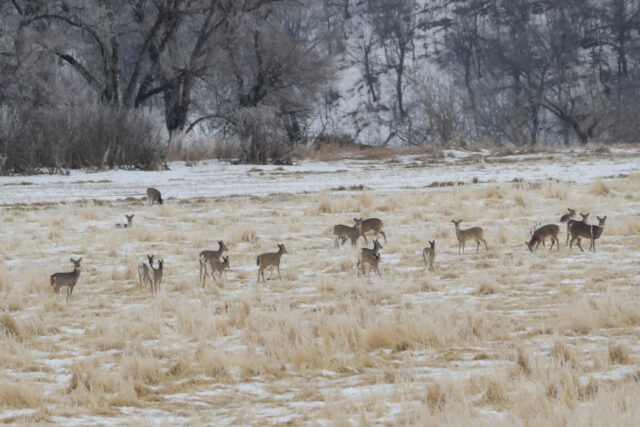Guest Post: Winter Wears On For Wildlife

Guest post from North Dakota Game & Fish outreach biologist Doug Lier.
The winter of 2023 started out in late fall of 2022 with snow and ice, then cold, more snow, some more ice and then cold. As long ago as it seems, the pounding humans, livestock and wildlife absorbed just the first couple months was significant. Fortunately, we settled into a little less snow and most of us would admit January wasn’t too bad compared to what December offered.
As my career spans years, I feel a little more confident assessing that the start of this winter was a little harsher than most and when the first reports of wildlife mortality started trickling in, the biologist in me admitted as bad as the beginning was, the true test would be coming in spring 2023.
When deer and pheasants die in November and December, it’s easy to understand how in any given winter those animals honestly wouldn’t have made it through winter anyway. That’s the harsh reality of how nature weeds out the small and the weak.
On the same note, the early start to winter meant fat reserves would be tapped into a little earlier than hoped. A late start to winter and soft beginning to 2023 would give animals a little shorter window of stress and better chance to survive into the spring.
As we see the light at the end of the tunnel signaling spring is on the way, it is shaded by the reality of last year when feet of snow and cold were causing stress for livestock producers and knocking power out for days and weeks.
Those same storms are a grim reminder of how true winter mortality can stretch into spring and how the critters need as much space as possible. We understand North Dakotans want to get outdoors and have fun in winter. Even so, the tougher the winter is, it is important that people riding snowmobiles, shed hunting, cross-country skiing or doing whatever are cognizant about where wildlife are and to view them from a distance.
That means waiting to shed hunt until later in the spring so that you’re not pushing deer in and out of thermal cover where they’re trying to just conserve energy. Animals forced into the open are exposed to the elements a lot more, which adds further stress. Also, people need to realize that harassing wildlife from snowmobiles or other machines is illegal in North Dakota.
It’s common for snowmobilers and others to ride in areas where snow has accumulated, such as near shelterbelts and other wooded habitat because that’s where the drifts are, but people also must realize there could be deer or other wildlife within those areas to get out of the weather. So, every time animals are pushed from those areas, it increases the amount of energy they expend to survive the next day.
These same warnings, for shed hunters, skiers and others, also apply on Game and Fish Department owned or operated wildlife management areas where many animals gather to weather the winter months.




